Click to Skip Ahead
Review Summary
We give Simple Solution Pet Stain & Odor Remover a rating of 4.5 out of 5 stars.
Introduction
Simple Solutions is one of over 20 brands of the parent company Compana Pet Brands, formerly Manna Pro Products. We appreciated the company’s commitment to products backed by science and being consumer-centric. Simple Solutions is more than 30 years old and is dedicated to solving pet odor issues.
The company offers all-around solutions, focusing on potty training and cleaning the messes that may occur in the process. It’s a laudable cause since elimination problems are one of the issues behind pet relinquishment. They make products for various animals, including dogs, cats, poultry, small animals, horses, and birds. It’s also worth noting that the parent company has a Chief Veterinary Officer to ensure quality and safety.
At a Glance: The Best Simple Solution Products:
| Image | Product | Details | ||
|---|---|---|---|---|
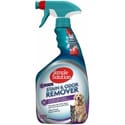
|
Simple Solution Pet Stain & Odor Remover |
|
CHECK PRICE | |
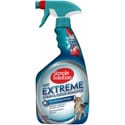
|
Simple Solution Extreme Cat Stain & Odor Remover |
|
CHECK PRICE | |
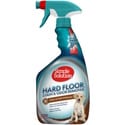
|
Simple Solution Hardfloor Stain & Odor Remover |
|
CHECK PRICE | |
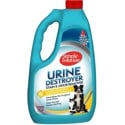
|
Simple Solution Pet Urine Destroyer |
|
CHECK PRICE | |
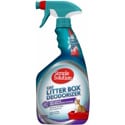
|
Simple Solution Cat Litter Box Deodorizer |
|
CHECK PRICE |

Simple Solution Pet Stain & Odor Remover Reviewed
Simple Solution Pet Stain & Odor Remover effectively cleans and deodorizes stains while removing odors that can encourage repeat offenses. It’s a critical element of housebreaking and litter box training. Instincts and lingering smells lead pets to go back to the same places to eliminate. A product that can break the cycle is a godsend for caregivers. It uses a proprietary pro-bacteria and enzyme formula to achieve this.
That approach is unique. Many manufacturers produce items that cover up the odors in hopes they’ll dissipate over time. While that may be true, it isn’t an effective way to deal with the problem. The wiser course of action is to eliminate the cause, which Simple Solution Pet Stain & Odor Remover does.
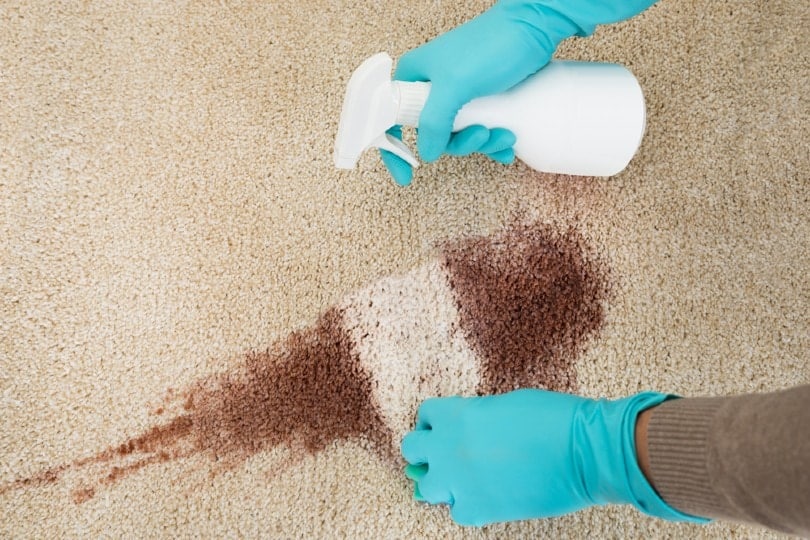
Who Makes Simple Solution Pet Stain & Odor Remover, and Where Is It Produced?
The parent company’s corporate headquarters is based out of St. Louis, MO. Simple Solution touts the fact that it’s USA-based. It is a private, independent business. Manna Pro Products acquired several other brands before rebranding as Compana Pet Products, including Oxbow Animal Health and Zupreem, to expand its presence in the pet industry. The organization aims to offer a complete portfolio of solutions.
The company’s reach into different branches of the pet industry is unique. It recognizes the various aspects of caring for the pets and the solutions they’ll need. The line of cat products speaks to this specialization and knowledge of their market.
Which Type of Pet Is Simple Solution Pet Stain & Odor Remover Best Suited For?
Simple Solution Pet Stain & Odor Remover is suited for dogs and cats, although it also produces products better suited for felines and their unique problems. You can use the product on any water-safe surface. Variations of the original version include one with a floral scent and one that is “Oxy charged.” There is also an extreme version for tough stains and odors and one suited for hard floors.
Discussion of the Product Quality
Simple Solution Pet Stain & Odor Remover gets to the heart of the matter by trying to break down foul smells instead of covering them up without solving the problem. Pleasant scents only disguise the problem and don’t fix the issue. Let’s get into some of the details.
Odor Elimination Timeframe
Simple Solution Pet Stain & Odor Remover doesn’t eliminate odors immediately. That’s not unexpected for the type of product it is. However, some consumers may expect quick action and become impatient because of the time it takes to work. That isn’t a failing of the product; it’s simply a statement of its action.
The company has an “Oxy” version of the product. OxiClean capitalized on the unique chemistry of sodium percarbonate and its cleaning ability. That’s the stain component of Simple Solution. The acidity of urine can discolor fabrics and carpets, making this feature vital.

A Pleasant Scent
We don’t like products that solve odor issues by covering them up. While Simple Solution Pet Stain & Odor Remover has a pleasant scent, it’s not overpowering. We like to think of it as a transition while the product gets to work on the problem. It’s a good compromise between its ability to tackle the job and the time it needs to eliminate odors.
Various Solutions
We like that the company recognizes different challenges when dealing with odor control. A one-size-fits-all product isn’t always possible when dealing with different surfaces. Pet owners may also need something heavy-duty in some cases. Simple Solution has you covered in all these cases. You’ll find products of varying strengths and for use on different surfaces. You can also get concentrated versions for covering large surfaces.

A Quick Look at Simple Solution Pet Pet Products
- Effective with quick action
- No toxic byproducts
- Pleasantly scented products available
- Made in USA
- Slick surfaces for hard flooring

Reviews of the 3 Best Simple Solution Products
1. Simple Solution Pet Stain & Odor Remover

The Simple Solution Pet Stain & Odor Remover is the flagship product in the manufacturer’s line. It’s convenient to use with its spray bottle design. It breaks down the causes of the problem, which makes it more effective than something that simply covers up the odors. The reviews we saw online were overwhelmingly positive. The product is also affordably priced, a pleasant surprise compared to comparable items.
- Affordable
- Made in USA
- Pleasant Smell
- Eliminates the source instead of covering it up
- Takes longer to work than some people would like
2. Simple Solution Extreme Cat Stain & Odor Remover
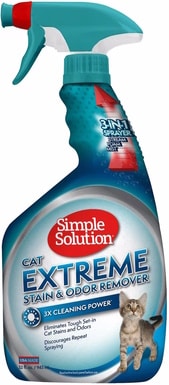
The Simple Solution Extreme Cat Stain & Odor Remover ups the ante with more enzymes to deal with this issue. Cat urine is more concentrated and, thus, more pungent. It’s an excellent segue for the company to address this concern and stem complaints that the original formula isn’t strong enough. They succeeded admirably with this approach. It falls in line with their mission to offer effective solutions.
- Formulated for cat urine
- Made in USA
- 3-in-1 nozzle sprayer
- Works best on cat urine only
3. Simple Solution Hardfloor Stain & Odor Remover

The Simple Solution Hardfloor Stain & Odor Remover addresses a unique need to deal with problems on these surfaces. They are porous and, thus, can absorb foul smells. However, you must also balance it with the possible damage they can cause. It does the job without marring the surfaces. It’s one of the few products we saw that offered solutions in these cases. Kudos to Simple Solution!
- Safe for marble, concrete, stone, ceramic, and sealed wood floors
- 3-in-1 nozzle sprayer
- Dual-action formula
- Eliminates odors better than it does stains
What Other Users Are Saying
Don’t just take our word for it! Take a look at what others think about this product.
- Chewy – “No smell, no spotting. Also cleans upholstery nicely!”
- Petco – “It smells great and completely eliminates any potty odors.”
- Amazon – As pet owners, we always double-check with Amazon reviews from buyers before we buy something. You can read these by clicking here.
Conclusion
An effective stain and odor remover is critical for new pet owners. Inevitably, accidents happen. It’s essential for preventing a vicious cycle of repeat episodes. Simple Solution Pet Stain and Odor Remover offers a viable product that attacks the problem with basic biology. Enzymes do the heavy lifting to help dog owners avoid labor-intensive scrubbing and cleaning to get rid of odors and repeat occurrences, making it a necessary tool to have if you’ve got pets at home.
Featured Image Credit: Simple Solution














